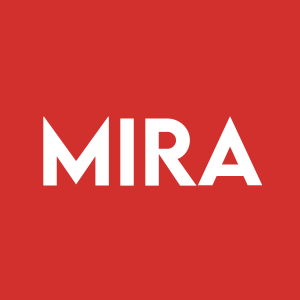MIRA Pharmaceuticals' Second Ketamir-2 Manuscript Accepted for Peer-Reviewed Publication Demonstrating Superior Efficacy in Preclinical Neuropathic Pain Models Versus Ketamine, Gabapentin, or Pregabalin
Rhea-AI Summary
MIRA Pharmaceuticals (NASDAQ:MIRA) announced the acceptance of a second peer-reviewed manuscript in Frontiers in Pharmacology highlighting their lead drug candidate Ketamir-2's superior performance in treating neuropathic pain. The study demonstrated that Ketamir-2 outperformed existing treatments like ketamine, pregabalin, and gabapentin in preclinical models.
The global neuropathic pain market, valued at $7.97 billion in 2024, is projected to reach $16.79 billion by 2034, growing at a CAGR of 7.73%. In the U.S., the market is expected to grow from $2.79 billion to $5.92 billion by 2034.
The company is progressing with its Phase 1 trial in Israel and plans to submit a Phase 2a clinical trial protocol to the FDA in Q4 2025, targeting study initiation by year-end.
Positive
- Superior efficacy demonstrated in preclinical models compared to existing treatments
- Large market opportunity with global neuropathic pain market projected to reach $16.79B by 2034
- Clean pharmacology and favorable safety profile in Phase 1 trials to date
- Potential applications beyond neuropathic pain including depression, anxiety, and PTSD
Negative
- Phase 2a trials not yet initiated - still in early clinical development stage
- Will face competition in a market dominated by established treatments
Insights
MIRA's Ketamir-2 shows superior pain relief in preclinical models compared to existing treatments, strengthening its clinical development path.
This acceptance of MIRA Pharmaceuticals' second peer-reviewed manuscript represents a significant validation for their lead candidate Ketamir-2. The preclinical data demonstrates superior efficacy compared to established treatments across two gold-standard neuropathic pain models, which is particularly noteworthy for several reasons.
The compound showed remarkable performance against three current standard-of-care treatments: ketamine, pregabalin, and gabapentin. In the Chung model (nerve ligation), Ketamir-2 restored sensory thresholds while ketamine showed no measurable benefit in male rats. In female rats, it outperformed both pregabalin and gabapentin. Similarly, in the paclitaxel-induced neuropathy model, Ketamir-2 produced more complete normalization of pain sensitivity than gabapentin in both genders.
What's mechanistically distinctive is Ketamir-2's selective binding to the PCP site of NMDA receptors with low affinity and minimal interaction with over 40 other receptor systems. This selectivity likely explains its improved efficacy profile while potentially avoiding the side effects associated with broader receptor engagement seen with ketamine.
The
With the Phase 1 trial progressing without reported safety concerns and plans for Phase 2a by year-end, MIRA is executing a clear clinical development strategy. The potential applications beyond neuropathic pain (depression, anxiety, PTSD) could further expand Ketamir-2's commercial potential if similar efficacy is demonstrated in those indications.
Manuscript accepted for publication in Frontiers in Pharmacology, "Oral Administration of Ketamir-2, a Novel Ketamine Analog, Attenuates Neuropathic Pain in Rodent Models via Selective NMDA Antagonism" details Ketamir-2's superior performance in two validated neuropathic pain models and supports advancement to Phase 2a clinical trials by year-end 2025.
MIAMI, FL / ACCESS Newswire / August 12, 2025 / MIRA Pharmaceuticals, Inc. (NASDAQ:MIRA) ("MIRA" or the "Company"), a clinical-stage pharmaceutical company developing novel oral therapeutics for neurologic, neuropsychiatric, and metabolic disorders, today announced the acceptance of a second peer-reviewed manuscript describing its lead oral drug candidate, Ketamir-2, in Frontiers in Pharmacology.
The newly accepted publication reports that Ketamir-2 outperformed ketamine, pregabalin, or gabapentin-depending on the comparator used-in restoring sensory function and reversing pain behaviors across two gold-standard rodent models of neuropathic pain. The findings build on MIRA's first publication characterizing Ketamir-2's clean pharmacology and favorable safety profile and align with the Company's plan to initiate a Phase 2a trial in neuropathic pain by year-end 2025.
Market Opportunity
Neuropathic pain represents a significant and underserved market across North America. Epidemiology suggests approximately 7
Ketamir-2's differentiated mechanism, oral bioavailability, and superior performance in gold-standard preclinical models position it as a potential next-generation, non-opioid treatment option in this multi-billion-dollar and rapidly growing market.
Key Findings from the Publication
Chung Model (sciatic nerve ligation in rats)
Male rats: Ketamir-2 restored sensory thresholds toward baseline, while ketamine-tested as the comparator-showed no measurable benefit.
Female rats: Ketamir-2 outperformed both pregabalin and gabapentin, delivering greater and more consistent restoration of normal sensory responses.
Paclitaxel (PTX)-Induced Neuropathy in Mice
Gabapentin was the sole comparator in this chemotherapy-induced neuropathy model. Ketamir-2 produced more complete normalization of pain sensitivity in both male and female cohorts, while gabapentin provided only partial or inconsistent relief.
Efficacy Across Genders and Species
Despite differences in baseline pain sensitivity between male and female animals, Ketamir-2 demonstrated clear and significant therapeutic benefit in every cohort tested.
Mechanistic Differentiation
Ketamir-2 is a new molecular entity that selectively binds to the PCP site of the NMDA receptor with low affinity and shows no significant interaction with over 40 other receptor systems, including serotonin, dopamine, and opioid receptors. This combination of selectivity, oral bioavailability, and demonstrated efficacy in gold-standard models suggests the potential for a differentiated, next-generation therapeutic option in neuropathic pain.
"The acceptance of this second peer-reviewed publication is another important milestone for our Ketamir-2 program," said Erez Aminov, CEO of MIRA. "The data clearly demonstrate superior and more consistent pain relief compared to leading neuropathic pain drugs, within the specific models tested. This provides additional confidence as we advance Ketamir-2 toward Phase 2a clinical evaluation and continue to explore its potential in broader CNS applications."
"The robust reversal of pain sensitivity observed in these well-validated preclinical models-whether compared to ketamine, pregabalin, or gabapentin-further supports Ketamir-2's potential as a differentiated, orally administered treatment for neuropathic pain," added Dr. Itzchak Angel, Chief Scientific Advisor. "Given the limited number of effective oral treatments for this indication, Ketamir-2's profile is especially compelling."
Clinical Development Update
Phase 1 Trial Progressing: The ongoing Phase 1 trial of Ketamir-2 in Israel is on schedule, with no safety concerns reported to date and the single ascending dose portion nearing completion.
Phase 2a by Year-End: MIRA plans to submit a Phase 2a clinical trial protocol to the U.S. Food and Drug Administration (FDA) in Q4 2025 as an advanced development version to its active IND, with the goal of initiating the study in neuropathic pain by year-end.
Potential Beyond Neuropathic Pain: With its clean pharmacology and oral bioavailability, Ketamir-2 is also being explored for potential applications in depression, anxiety, post-traumatic stress disorder (PTSD), and as a topical formulation for localized pain conditions.
The full publication will be available upon release at:
www.frontiersin.org/journals/pharmacology
About MIRA Pharmaceuticals, Inc.
MIRA Pharmaceuticals, Inc. (NASDAQ:MIRA) is a clinical-stage pharmaceutical company focused on the development and commercialization of novel therapeutics for neurologic, neuropsychiatric, and metabolic disorders. The Company's pipeline includes oral drug candidates designed to address significant unmet medical needs in areas such as neuropathic pain, inflammatory pain, obesity, addiction, anxiety, and cognitive decline.
Cautionary Note Regarding Forward-Looking Statements
This press release and the statements of MIRA's management related thereto contain "forward-looking statements," which are statements other than historical facts made pursuant to the safe harbor provisions of Section 27A of the Securities Act of 1933, as amended, and Section 21E of the Securities Exchange Act of 1934, as amended. These statements may be identified by words such as "aims," "anticipates," "believes," "could," "estimates," "expects," "forecasts," "goal," "intends," "may," "plans," "possible," "potential," "seeks," "will," and variations of these words or similar expressions that are intended to identify forward-looking statements. Any statements in this press release that are not historical facts may be deemed forward-looking. Any forward-looking statements in this press release are based on MIRA's current expectations, estimates, and projections only as of the date of this release and are subject to a number of risks and uncertainties (many of which are beyond MIRA's control) that could cause actual results to differ materially and adversely from those set forth in or implied by such forward-looking statements, including related to MIRA's potential merger with SKNY Pharmaceuticals, Inc. These and other risks concerning MIRA's programs and operations are described in additional detail in the Annual Report on Form 10-K for the year ended December 31, 2024, and the Form 14A filed by MIRA on June 18, 2025, and other SEC filings, which are on file with the SEC at www.sec.gov and on MIRA's website at https://www.mirapharmaceuticals.com/investors/sec-filings. MIRA explicitly disclaims any obligation to update any forward-looking statements except to the extent required by law.
Contact:
Helga Moya
info@mirapharma.com
(786) 432-9792
SOURCE: MIRA Pharmaceuticals
View the original press release on ACCESS Newswire








